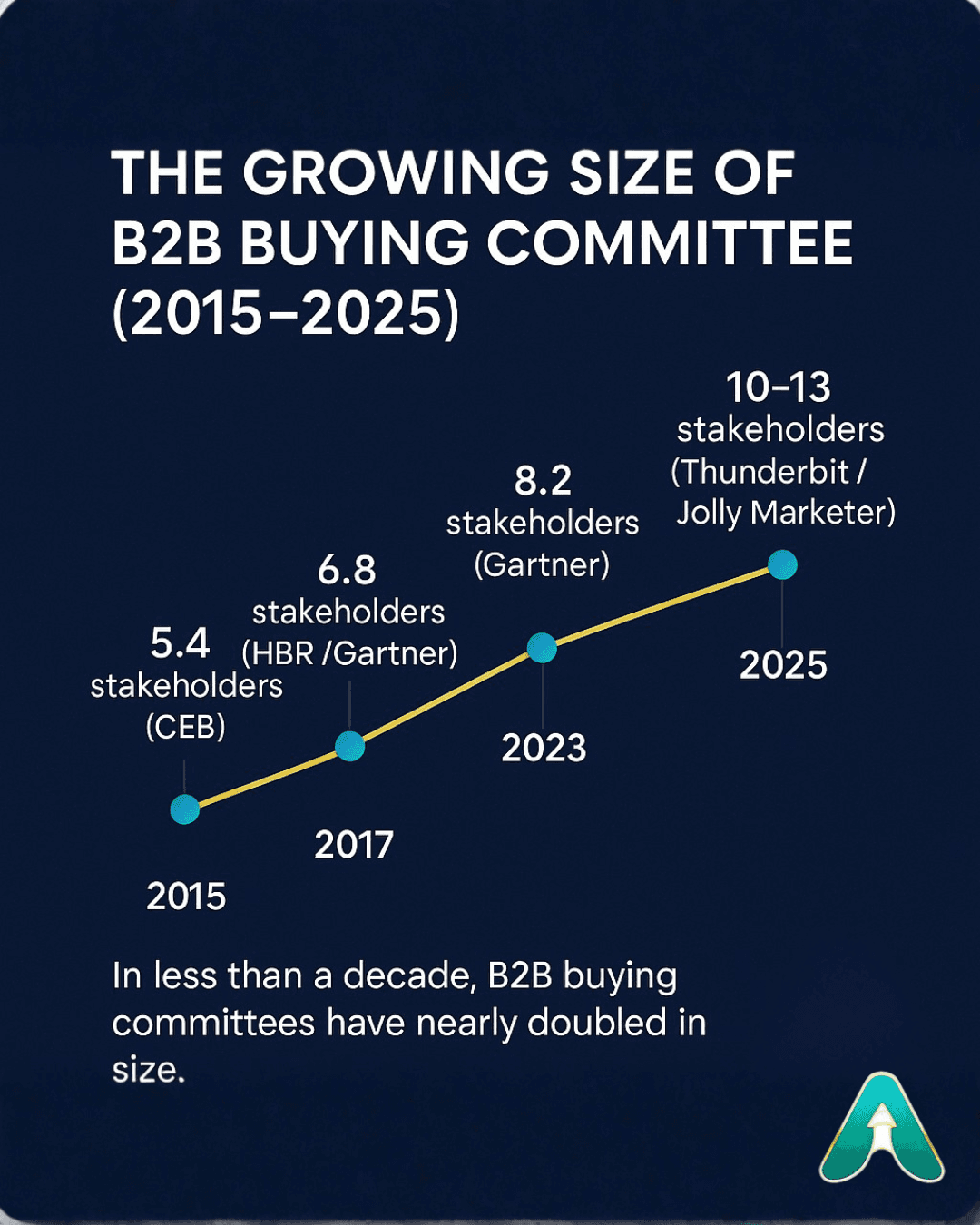B2B Buying Committees Have Doubled in the Last Decade: How Multi-Stakeholder Decisions Are Changing Sales and GTM Strategy
David Cyrus
Founder & CEO, Attainment

AI Summary
B2B buying committees have nearly doubled in size over the past decade, from 6.8 in 2017 (Harvard Business Review) to as many as 13 in some enterprise deals today. This article explores why and how companies can adapt by aligning marketing, sales, and product teams around consensus-driven GTM strategies. It outlines nine practical levers of GTM maturity to help businesses navigate multi-stakeholder decisions and win in the era of complexity.
Why B2B Buying Committees Have Doubled in the Last Decade
In 2017, Harvard Business Review revealed that the average B2B purchase involved 6.8 decision-makers. At the time, that number seemed high. Yet nearly ten years later, the figure has surged.
Gartner (2023) and Jolly Marketer (2025) report that buying groups now include between 8 and 13 stakeholders depending on company size and deal complexity. Some enterprise deals involve even more. Buying decisions now include IT, finance, operations, compliance, legal, procurement, and executive leadership.
The shift reflects a new reality: decisions are no longer made by individuals but by committees. And most GTM strategies haven't caught up.

The question isn't "Who's our buyer?" It's "Who's in the room when the decision is made?"
The Growth of Buying Committees: A Decade in Data
| Year | Avg. Stakeholders | Source | Notes |
|---|---|---|---|
| 2015 | 5.4 | CEB / Gartner | Early benchmark; department-level decisions |
| 2017 | 6.8 | Harvard Business Review | The "Challenger Customer" era |
| 2023 | 8.2 | Gartner | More cross-functional influence |
| 2025 | 8–13 | Jolly Marketer / Thunderbit | Enterprise and SaaS deals now consensus-driven |
That's nearly a 100% increase in a single decade.
Top Reasons B2B Buying Committees Keep Expanding
1. Digital Transformation Made Everything Interconnected
Every purchase now affects multiple systems and teams. Even marketing software decisions involve IT, data, and compliance.
2. Risk Aversion Increased Post-COVID
Procurement expanded to include risk and finance oversight in every major decision. The caution has persisted.
3. New Roles Have Emerged
AI governance, ESG, and data privacy leads are now regular stakeholders. Each adds a layer of review.
4. Hybrid Work Slows Consensus
Virtual collaboration increases friction and delays. Latecomers often re-open decisions.
5. The Cost of Failure Is Higher
Distributed accountability reduces individual decision-making power.
Buying is now a team sport—and the results are visible: longer cycles, more "no decisions," and slower pipeline velocity.
How Growing Buying Committees Are Reshaping B2B Sales Cycles
Traditional GTM models were built for a simpler time: generate leads, nurture, hand off to sales, and close. But modern buying is non-linear and consensus-driven.
How Decision Friction Impacts Pipeline Performance
- Single-Persona Messaging – Campaigns often target one buyer type, alienating others. The CFO hears "spend," while the CMO hears "growth."
- Lead-Based Metrics Create False Positives – Multiple contacts from the same company distort metrics. Six leads might mean one buying group, not six opportunities.
- Sales Single-Threading – Overreliance on one champion risks deal collapse if they leave.
- Content Misalignment – One-size-fits-all messaging fails to circulate internally.
- Internal Misalignment – When teams inside your company can't agree on the buyer, neither can the buyer.
The modern GTM challenge isn't generating demand—it's orchestrating alignment.
The Cost of Outdated Go-to-Market (GTM) Models in a Multi-Stakeholder World
Companies stuck in outdated GTM frameworks face declining conversion and longer deal cycles. The root cause? They're optimized for persuasion, not consensus.
The Nine Levers of GTM Maturity: How Leading Teams Adapt to Complex Buying
- Stakeholder Mapping – Identify influencers, blockers, and their internal relationships. Understand how decisions flow, not just who signs off.
- Persona-Based Messaging – One story, expressed in multiple stakeholder languages (CFO = ROI, CTO = Security, CMO = Growth).
- Multi-Threaded Sales Engagement – Build parallel relationships early. More threads mean higher win rates.
- Account-Based Marketing (ABM) – Align sales and marketing around accounts, not individuals. Replace "lead conversion" with "organizational alignment."
- Buyer Enablement Content – Create materials that help buyers sell internally (ROI decks, comparison charts, compliance summaries).
- Champion Enablement – Equip internal advocates with the resources to influence others.
- Sales-Marketing Synchronization – Operate like an orchestra, not a relay race.
- Product and SME Integration – Bring experts into early conversations to establish credibility.
- Feedback-Driven Refinement – Treat every lost deal as a source of insight. Learn where consensus broke down.
Building for Consensus: The New Skill Set of High-Performing GTM Teams
The new competitive advantage is alignment velocity—the speed at which your organization can align with your buyer's internal structure.
What Consensus Selling Looks Like in Practice
Consensus selling is facilitation, not persuasion. It's enabling the buyer's team to reach agreement faster.
Frameworks like Gartner's Buyer Enablement Model, Forrester's Buying Groups Framework, and the Challenger Mobilizer Model all reinforce this: simplify the buyer's process, reduce internal friction, and empower champions.
Case Study: How One SaaS Company Shortened a 9-Month Cycle by Aligning Stakeholders
A SaaS company selling workforce analytics struggled with stalled enterprise deals. They discovered 11 stakeholders in one account but only engaged HR and innovation leads. Finance, IT, and legal were disengaged.
By introducing stakeholder mapping, multi-threaded outreach, and enablement content, they cut deal cycles from nine months to five and doubled win rates within two quarters.
The Future of GTM Design: From Automation to Orchestration
Modern GTM strategies must evolve from automation to orchestration. AI, compliance, and ESG have made collective decision-making the new normal.
Four Capabilities Defining the Future of GTM Strategy
- Cross-Functional Insight Loops – Real-time sharing between marketing, sales, and product.
- Persona-Layered Messaging – One unified value narrative, expressed differently per stakeholder.
- Group-Level Intent Detection – Engagement tracking across the buying unit.
- Buyer Enablement Infrastructure – Scalable systems that make internal selling easier.
Quick GTM Maturity Check: Is Your Strategy Built for the 2025 Buying Reality?
- Do you map all stakeholders before pipeline creation?
- Does your content speak to finance, IT, and legal?
- Are metrics based on leads or account engagement?
- Does sales build multiple relationships per deal?
- Can your champion sell your product internally without you?
If you hesitated on any of these, your GTM is still built for 2017, not 2025.
People Also Ask
How do I identify all stakeholders in a B2B buying committee?
Start by mapping organizational charts and asking your champion: "Who else needs to approve this?" Look for cross-functional roles in IT, finance, legal, compliance, and operations. Use tools like LinkedIn Sales Navigator to identify decision-makers and influencers across departments.
What's the difference between Account-Based Marketing (ABM) and traditional lead generation?
Traditional lead generation focuses on individual contacts and conversion metrics. ABM treats entire accounts as markets of one, aligning sales and marketing around organizational engagement rather than individual leads. ABM is essential for multi-stakeholder buying because it addresses the committee, not just one person. Learn more about Account-Based Marketing strategies.
How can I shorten B2B sales cycles when dealing with large buying committees?
Focus on buyer enablement: create internal selling materials (ROI calculators, comparison charts, compliance summaries) that help your champion build consensus faster. Multi-thread your sales engagement to build relationships with multiple stakeholders simultaneously. Consider working with a Fractional CMO to optimize your GTM strategy for consensus-driven buying.
Ready to Evaluate Your GTM Maturity?
I offer GTM Maturity Audits through Attainment—hands-on diagnostics to identify friction points and align marketing, sales, and product teams around multi-stakeholder buying.
We'll map your GTM across the nine levers of maturity, quantify deal friction, and create a roadmap to accelerate consensus-building inside your buyer's organization.
Stay Updated on GTM Strategy
Get insights on go-to-market strategy, buyer enablement, and AI-powered growth delivered to your inbox.
Related Articles
Why CEO Visibility Has Become Business Infrastructure
Explore how executive visibility has evolved from optional PR to essential business infrastructure.
Read more →5 Key Attributes of a Great Product: The Core of Startup Success
Learn the five essential attributes for building great products that drive startup and scale-up success.
Read more →Share this article
Attainment Labs is a Go-to-Market strategy consultancy based in Toronto, Canada, serving B2B SaaS and technology companies across Canada, the United States, and APAC. We help founders and marketing leaders build scalable growth systems through Product Marketing, Fractional CMO services, and AI-powered GTM infrastructure designed for measurable revenue and profit attainment.
Keywords: Toronto B2B marketing, Canada Go-to-Market strategy, APAC expansion marketing, Fractional CMO Toronto